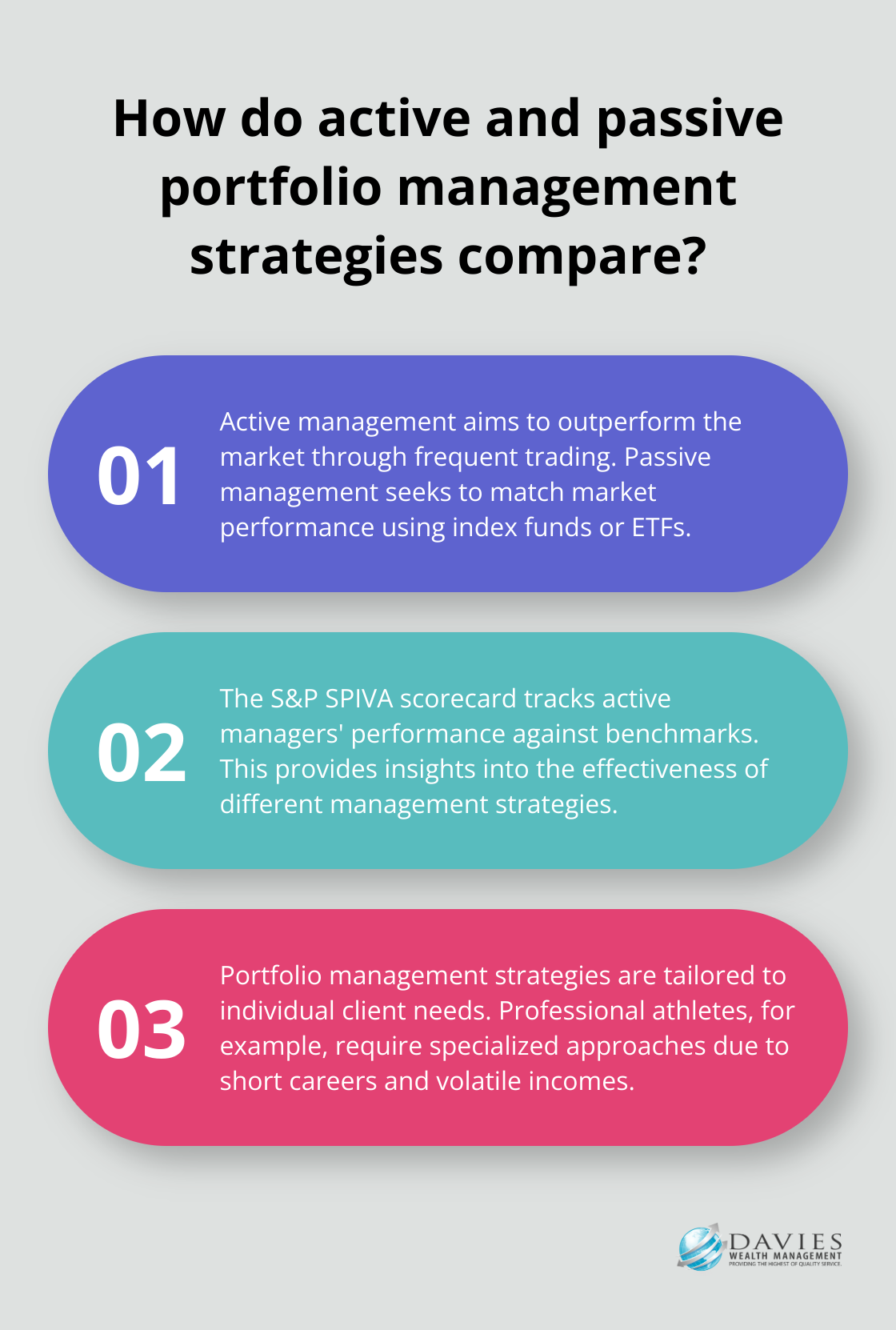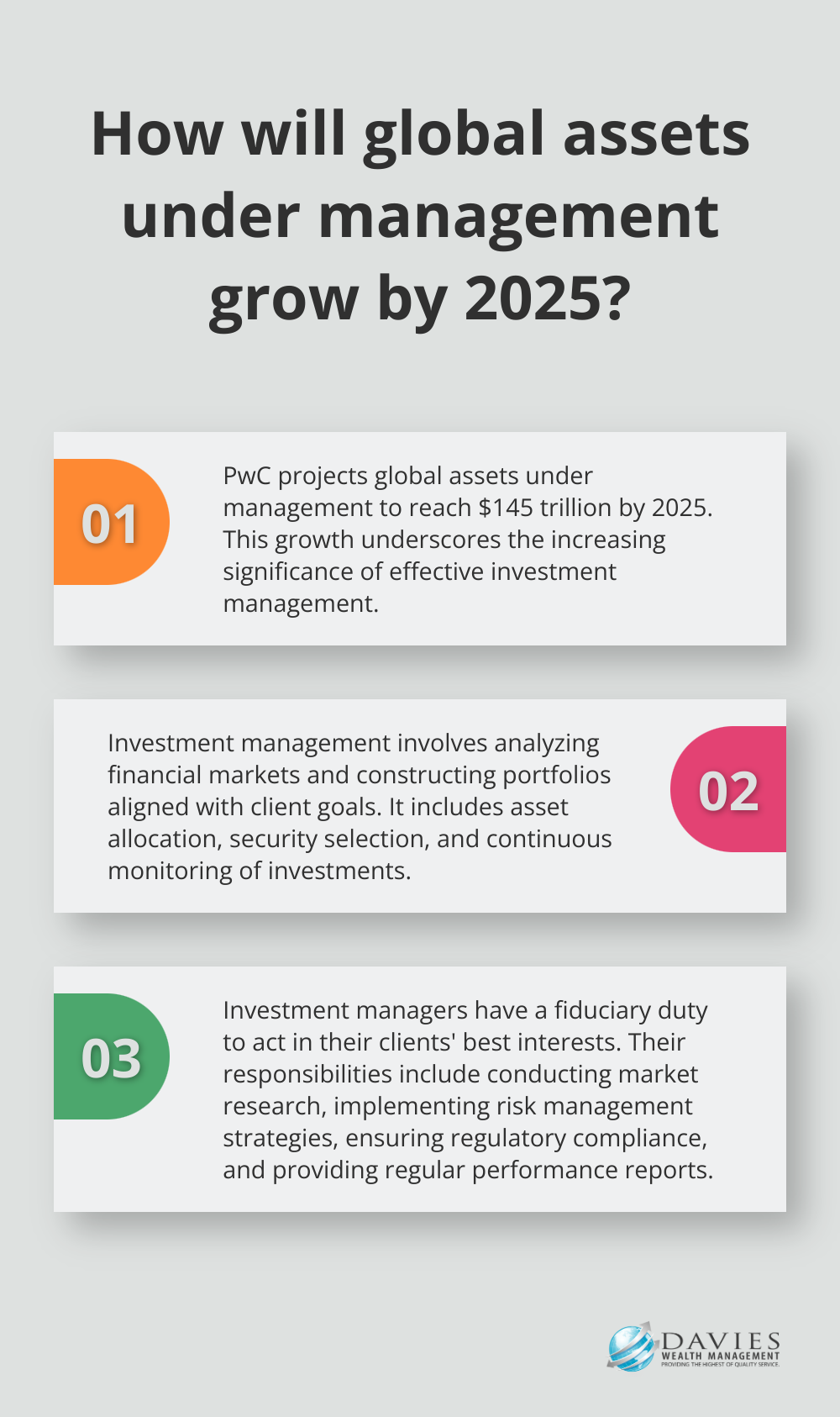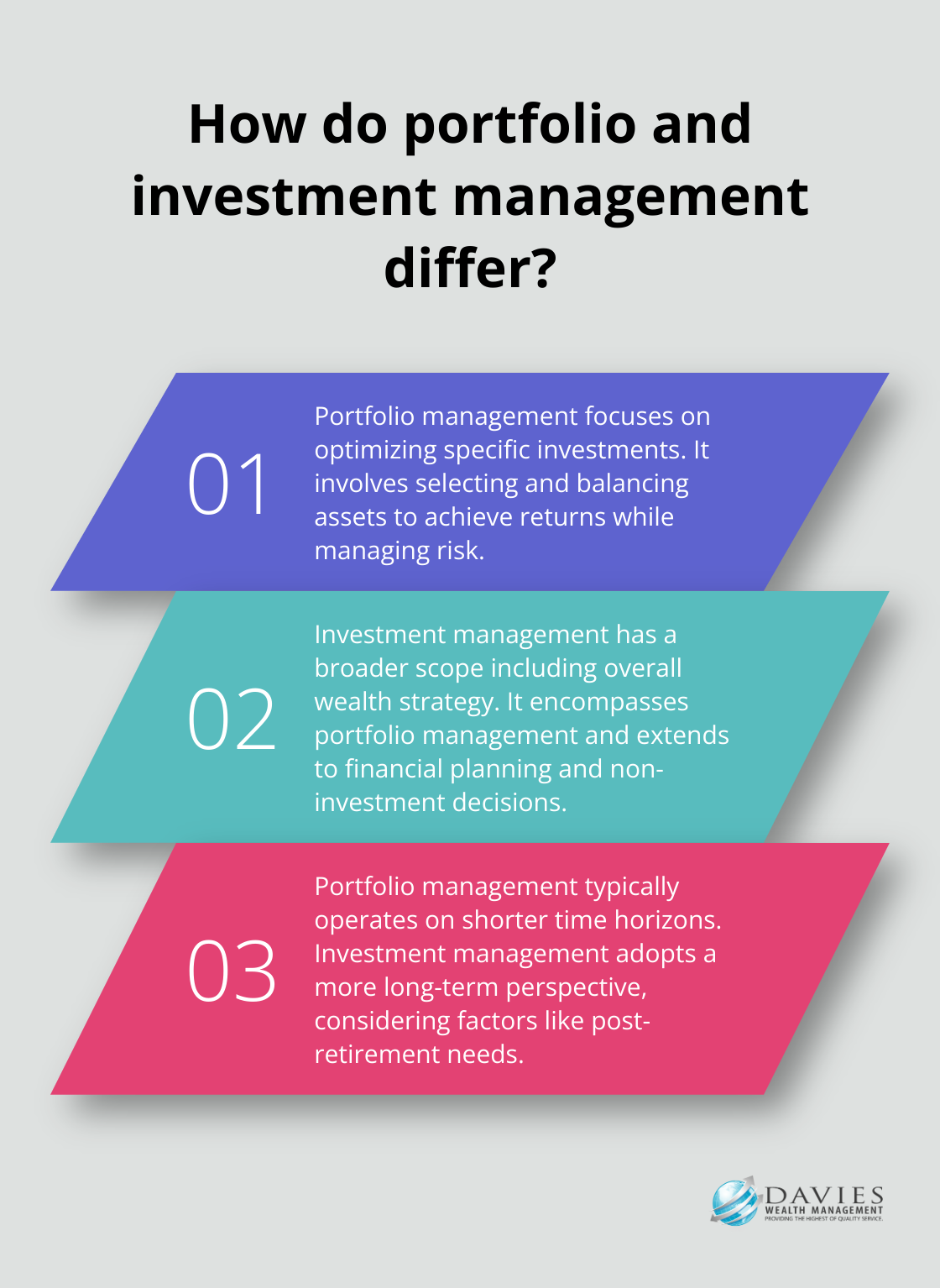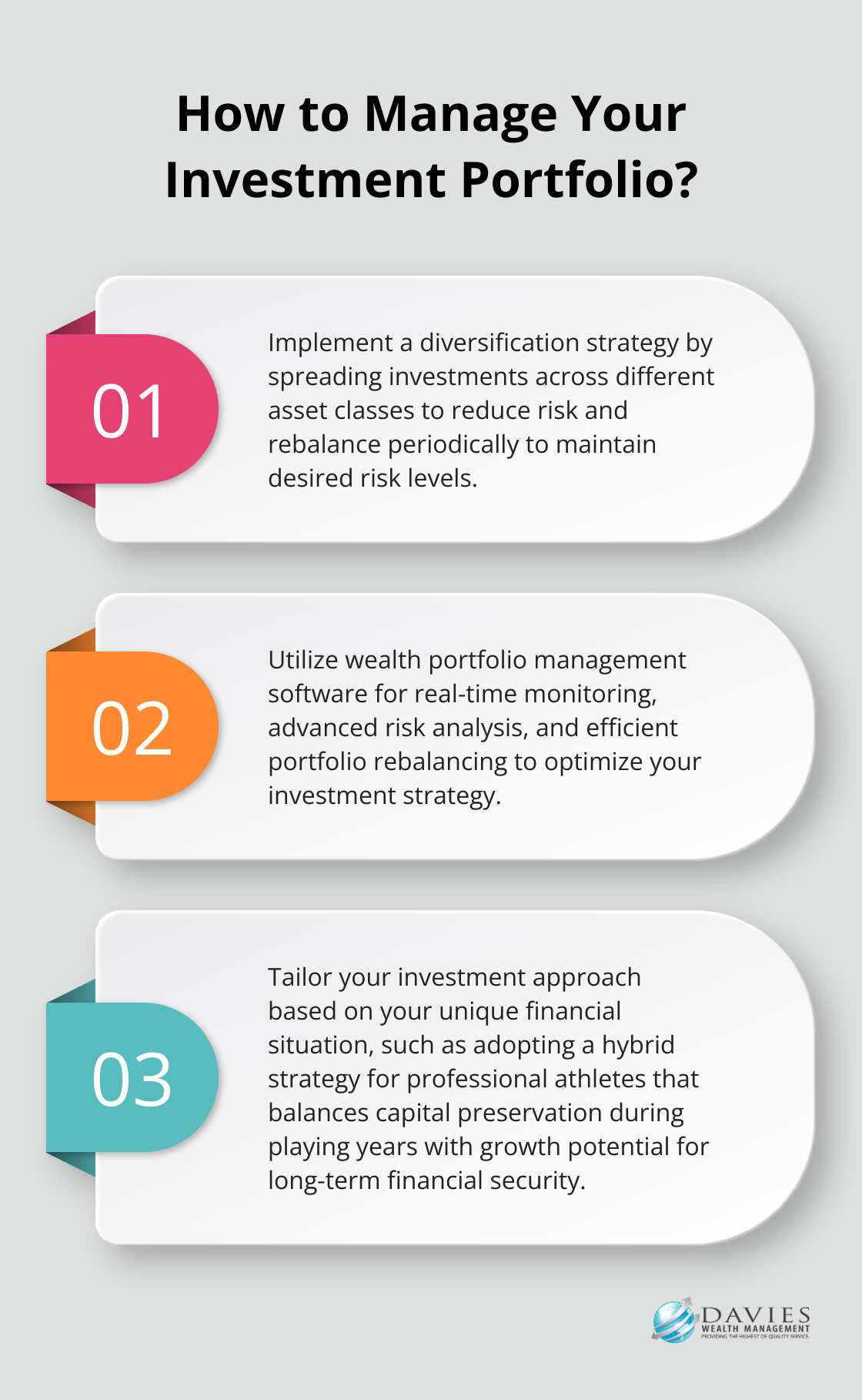At Davies Wealth Management, we often encounter clients who are unsure about the distinctions between portfolio and investment management. These terms are frequently used interchangeably, but they represent different aspects of financial strategy.
Understanding the nuances between these approaches is essential for making informed decisions about your financial future. In this post, we’ll explore the key differences and how wealth portfolio management software plays a role in optimizing both strategies.
What is Portfolio Management?
The Core of Portfolio Management
Portfolio management is a strategic approach to oversee and optimize a collection of investments. It involves making informed decisions about asset allocation, risk assessment, and investment selection. The goal extends beyond picking stocks or bonds; it aims to create a balanced, diversified portfolio that aligns with a client’s financial goals and risk tolerance.
Objectives and Strategies
The primary objective of portfolio management is to maximize returns while minimizing risk. This balance is achieved through various strategies:
- Diversification: This strategy spreads investments across different asset classes to reduce risk.
- Rebalancing: It involves periodic adjustments to portfolio allocations to maintain the desired risk level.
- Tax optimization: This approach minimizes tax liabilities through strategic investment decisions.
Active vs. Passive Management
Portfolio management strategies fall into two broad categories: active and passive approaches. Active management involves frequent buying and selling to outperform the market. Passive management, on the other hand, aims to match market performance through index funds or ETFs.

The S&P SPIVA (S&P Indices Versus Active) scorecard tracks the performance of active managers against their benchmarks over time, providing insights into the effectiveness of different management strategies.
Tailoring Strategies to Client Needs
Each client’s financial situation is unique, requiring tailored portfolio management strategies. For instance, professional athletes (a key client group for Davies Wealth Management) face specific financial challenges due to their short career spans and potentially volatile income streams.
A specialized approach for a young athlete might emphasize liquidity and capital preservation at the start of their career, gradually shifting towards growth-oriented investments as their financial stability increases.
The Role of Technology
Modern portfolio management increasingly relies on sophisticated software tools. These platforms enable real-time monitoring, advanced risk analysis, and efficient rebalancing of portfolios.
According to a Deloitte report, investment management firms are facing elevated risks and rewards in 2025 as they look to grow revenue, streamline processes, and leverage AI technologies.
As we transition to our discussion on investment management, it’s important to note how these portfolio management principles form the foundation for broader investment strategies.
What is Investment Management?
Investment management refers to the handling of an investment portfolio or a grouping of assets. It involves buying and selling assets, developing short- and long-term investment strategies, and overseeing financial assets. This strategic process extends beyond simple portfolio construction, involving a wide range of financial activities aimed at meeting specific client objectives.
The Scope of Investment Management
Investment management includes the analysis of financial markets, assessment of individual securities, and construction of portfolios that align with client goals. This process incorporates asset allocation, security selection, and continuous monitoring of investments. A PwC report projects global assets under management to reach $145 trillion by 2025, underscoring the increasing significance of effective investment management.
Core Responsibilities of Investment Managers
Investment managers hold a fiduciary duty to act in their clients’ best interests. Their responsibilities include:
- Conducting thorough market research and analysis
- Implementing risk management strategies
- Ensuring regulatory compliance
- Providing regular performance reports to clients
Investment Management Approaches
Several approaches to investment management exist, each with its own merits:
- Active Management: This approach aims to outperform the market through frequent trading and in-depth analysis. While potentially rewarding, it often involves higher fees and risks.
- Passive Management: This strategy seeks to mirror market performance, typically through index funds or ETFs. It generally costs less and can prove effective for long-term investors.
- Factor Investing: This method focuses on specific attributes or “factors” that have historically driven returns. BlackRock reports that factor investing can help improve portfolio outcomes.
Tailoring Strategies to Client Needs
Investment management strategies should adapt to each client’s unique situation. For professional athletes (a key client group for many wealth management firms), a hybrid strategy often balances the need for capital preservation during playing years with growth potential for long-term financial security.

As we move forward, we’ll explore the key differences between portfolio and investment management, providing insights into how these approaches can optimize financial outcomes.
Key Differences Between Portfolio and Investment Management
Scope and Focus
Portfolio management concentrates on optimizing a specific collection of investments. It involves selecting and balancing various assets within a portfolio to achieve desired returns while managing risk. Investment management encompasses a broader range of financial activities. It includes portfolio management but extends to overall wealth strategy, financial planning, and even non-investment related financial decisions.

A portfolio manager might focus on selecting the right mix of stocks and bonds for a client’s retirement account. An investment manager would consider this portfolio alongside other aspects like real estate holdings, business interests, and long-term financial goals to create a comprehensive wealth strategy.
Time Horizons and Strategy
Portfolio management typically operates on shorter time horizons, with more frequent adjustments based on market conditions and performance metrics.
Investment management adopts a more long-term perspective. For example, when working with professional athletes, financial advisors develop strategies that span beyond their playing careers, considering factors like post-retirement income needs and legacy planning.
Risk Management Approaches
Both disciplines prioritize risk management, but their approaches differ. Portfolio management focuses on diversification within the investment portfolio itself.
Investment management takes a holistic view of risk. It considers not just market risk, but also lifestyle risks, career volatility, and long-term financial security. For instance, when working with a professional athlete, advisors might recommend a more conservative investment approach during their playing years to offset the inherent career risks, gradually shifting to growth-oriented strategies as they transition to retirement.
Client Relationships and Customization
Portfolio management often involves a more transactional relationship with clients, focusing primarily on investment performance and adjustments. Investment management, however, requires a deeper understanding of a client’s overall financial situation, goals, and personal circumstances.
This difference in approach leads to varying levels of customization. While portfolio management can be tailored to some extent, investment management offers a higher degree of personalization, considering factors such as tax situations, estate planning needs, and long-term wealth transfer goals.
Final Thoughts
Portfolio and investment management serve distinct purposes in the financial landscape. Portfolio management optimizes specific investments, while investment management takes a broader view of long-term financial planning. Understanding these differences empowers individuals to make informed financial decisions and choose the right services for their needs.

At Davies Wealth Management, we combine portfolio and investment management approaches to provide comprehensive financial solutions. Our team utilizes wealth portfolio management software to enhance our capabilities, offering precise portfolio optimization while maintaining a broader perspective on our clients’ overall financial health. This integrated approach addresses immediate investment needs and aligns with long-term financial goals.
We equip ourselves to guide clients through every stage of their financial journey. Our commitment to personalized service and expertise in both portfolio and investment management positions us to help navigate the complexities of financial planning. For comprehensive wealth management services, visit Davies Wealth Management to learn how we can assist you in achieving lasting financial success.



Leave a Reply